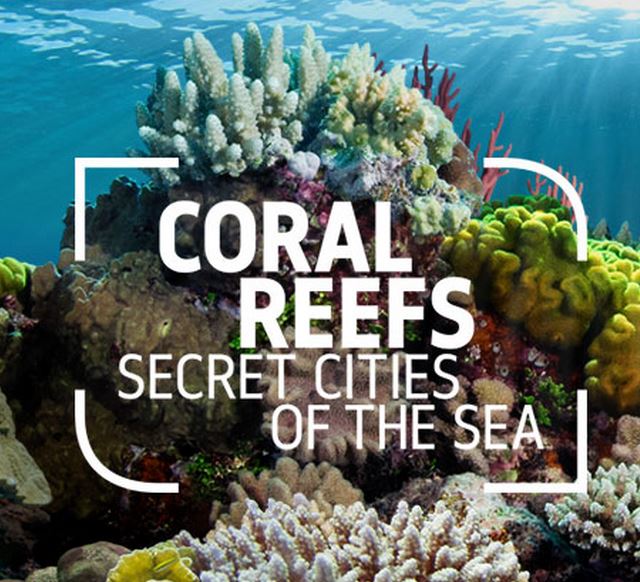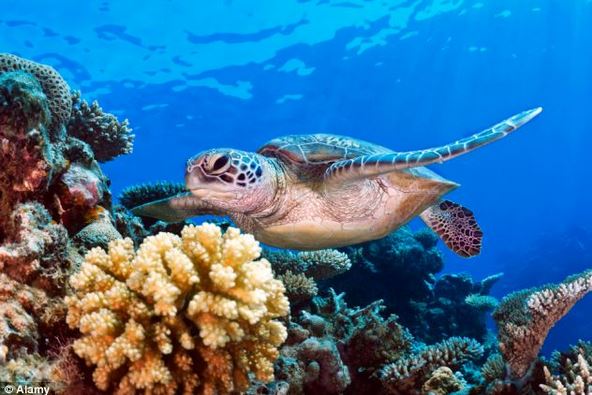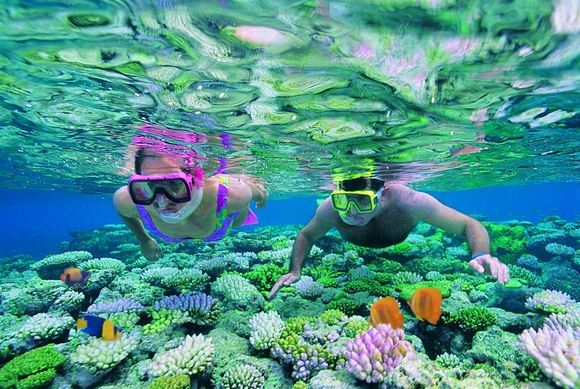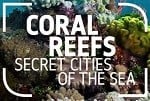Visitors can experience a spectacular Coral Reef virtual dive at the Natural History Museum in London, starting on March 27th, and explore the world’s most wonderful reefs without having to travel across the planet or getting wet.
The virtual dive, called “Coral Reefs: Secret Cities of the Sea,”, contains a bank of screens which provide a 360 degree virtual immersive experience, making you feel as if you really are there at the Great Barrier Reef off the coast of Australia, as well as some other famous sports where corals thrive.
The Museum says it is a bit like an under-the-sea “Google Street View” experience.

Visitors can enjoy a virtual experience of the most spectacular coral reefs in the world, without having to get wet. (Photo: Natural History Museum)
It will also include more than 200 exhibit’s from the Natural History Museum’s collection, including the venomous blue-ringed octopus and coral brought back by the English naturalist and geologist Charles Darwin – the Turbinaria coral.
The exhibition uses sound and lighting effects that create the sensation of being under the sea, hexagonal decorative elements modelled on the way coral grows, plus a virtual reef dive.
Catlin Seaview Survey images
Thanks to new technology and several images from the Catlin Seaview Survey, users can zoom in and explore several reefs from across the globe.
The Catlin Seaview Survey, sponsored by the Catlin Group, an insurance and reinsurance company, is a major scientific expedition aimed at documenting the composition and health of coral reefs worldwide.
Many of the Survey’s images have been included in the Museum’s virtual dive, such as Heron Island on the Great Barrier Reef, the Hourglass Reef in Bermuda, and the the Tubbataha Reef in the Philippines.

One quarter of marine species exist thanks to our Coral Reefs.
With state-of-the-art cameras, the Catlin Seaview divers took images every 3-to-6 seconds. These pictures where then placed side-by-side to create a panoramic view.
People need coral reefs
Dr Ken Johnson, a coral reefs expert at the Natural History Museum, said about corals:
“Coral reefs are not simply beautiful environments. They provide food, income and storm protection for many millions of people around the world.”
Felicity Paynter, who is in charge of creating the exhibition, said that initially she had to talk to several experts and carry out research, given that corals are not her field of expertise, she is a geographer by trade.
Ms. Paynter said:
“I had to think about what I wanted in there, but also what our visitors would want. What visitors might already know, what they don’t know and what questions we might be able to answer for them. On the one hand, there are lots of very cool weird and wonderful creatures that live on coral reefs, but there are also some really difficult and abstract concepts.”
“Once I knew what I wanted to explore as stories, it was about working with the curators to figure out which specimens would illustrate those stories best. And then working with the designers to create an experience for visitors – working out where in the narrative of the exhibition that they’re likely to feel surprised, amazed and emotional.”
According to the Catlin Group, which is helping sponsor the virtual dive:
“The research Catlin sponsors focuses on the oceans, which play a crucial role in the planet’s ecosystem. The Catlin Seaview Survey is an ambitious scientific project that since 2012 has documented the health of coral reefs worldwide.”
“Previously, Catlin sponsored the Catlin Arctic Survey, a three-year project that investigated changes in the fragile Arctic environment, including sea-ice melt.”
What are Coral Reefs?
Commonly referred to as the “rainforests of the sea,”, Coral Reefs form some of the oceans’ most diverse ecosystems.
Only 0.1% of the oceans’ surface is occupied by Coral Reefs, but they provide a habitat for about one-quarter of all species that live in our seas, including crustaeans, echinoderms, tunicates, sponges, fish, and mollusks.
Coral reefs are typically found in the warm waters of the tropics, but also exist in deeper and colder parts of our oceans.

Experts say ecotourism is harming coral reef health.
Coral Reefs are extremely sensitive to environmental changes, especially temperatures. Their survival is currently seriously threatened by climate change, the oceans becoming more acidic, blast fishing, ecotourism, and human population growth along coastal regions.
According to a number of studies, about 10% of the world’s Coral Reefs are now dead, and about 60% are at risk of dying due to destructive, human-related activities.
Approximately 95% of reefs in Southeast Asia are at risk, say experts. Globally, about 90% of all reefs worldwide will eventually be at risk from both climate change and human activities.
The current expansion of the Port of Miami is causing lasting damage to nearby coral reefs, according to US media reports. The Army Corps of Engineers, which is supervising the dredging, assured local authorities, environmentalists and the general public that the expansion of the port would in no way harm coral life nearby.
Rachel Siverstein, Executive Director of Biscayne Bay Waterkeeper, which is heading a lawsuit against the Army Corps of Engineers, said to the New York Times:
“We’ve seen profound and severe impacts to our reef just off of Miami; it looks like a moonscape. This damage stems from the fact that the corps and the contractors simply weren’t following the rules that were laid out for them when they started this project.”
National Geographic Video – Coral Reefs

